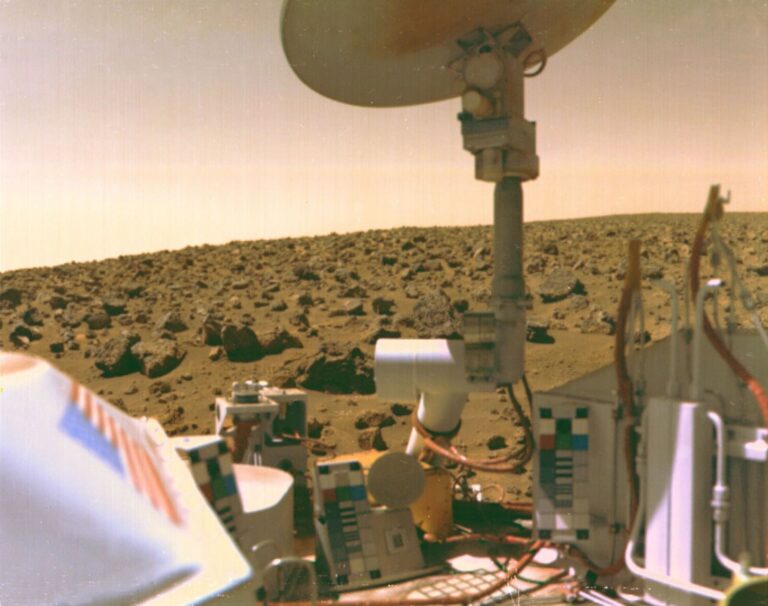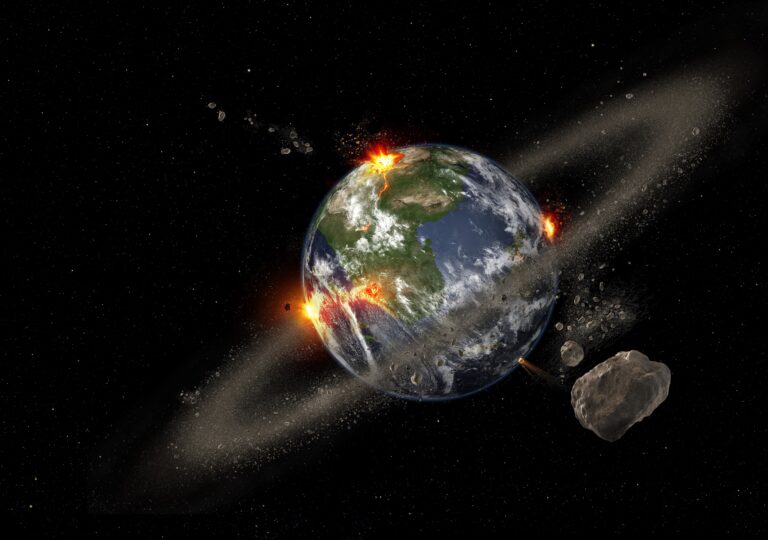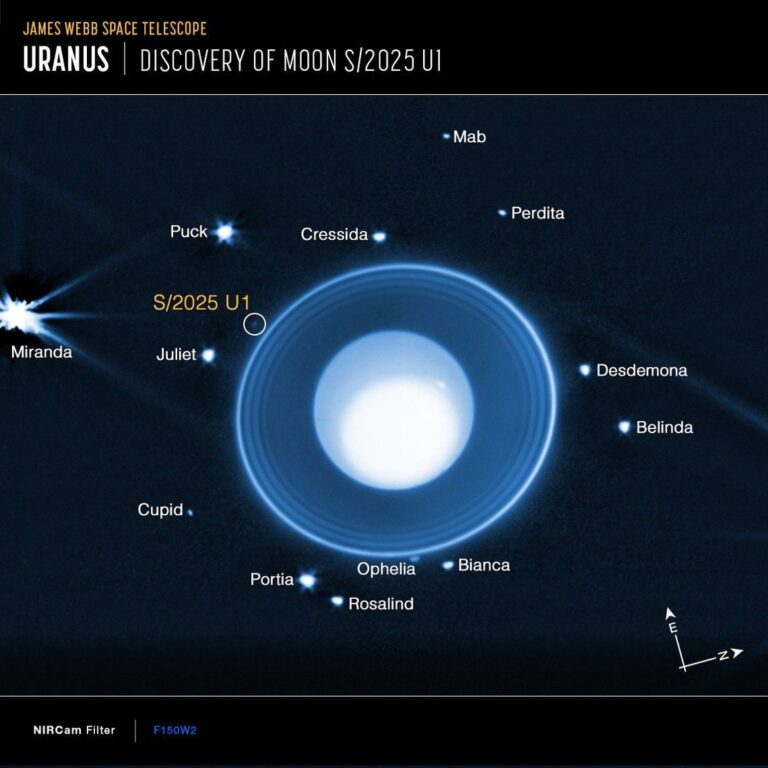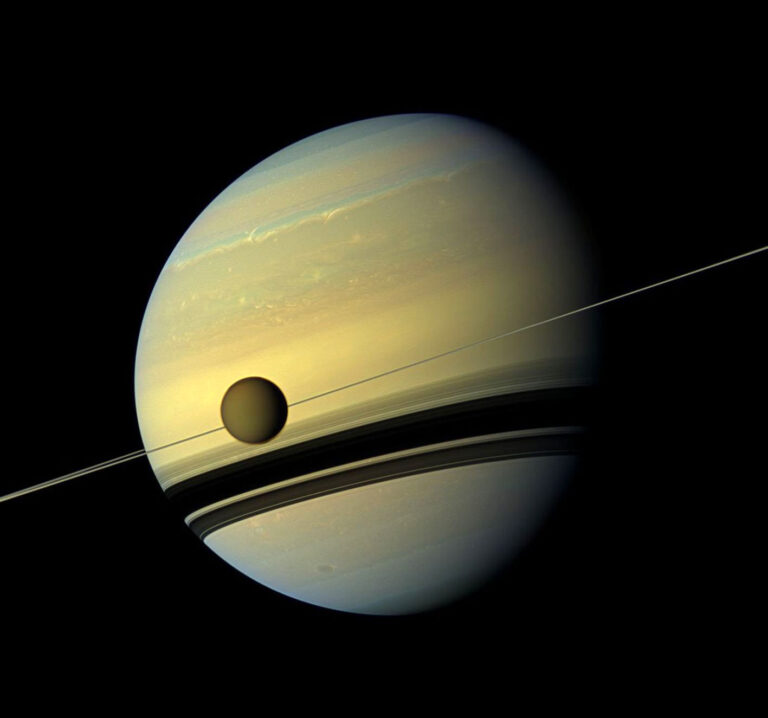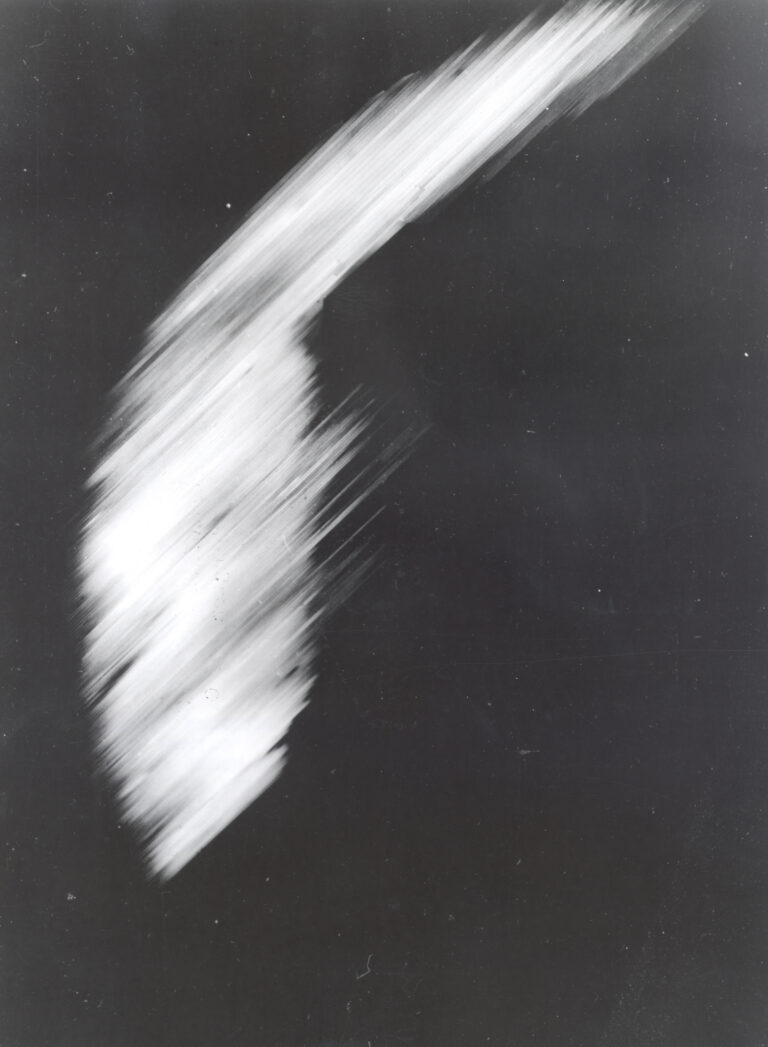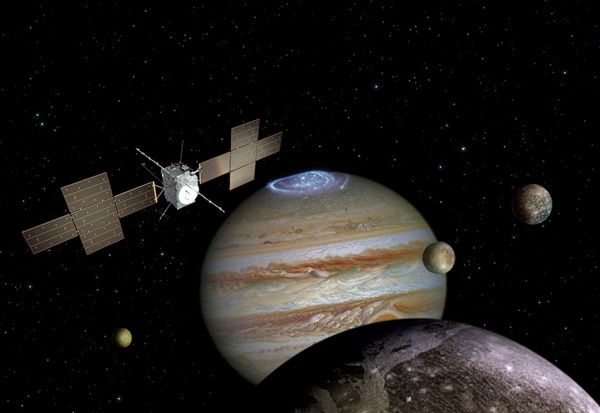
Key Takeaways:
[Editor’s note: This article was updated on April 14 to include details on the successful launch of the JUICE spacecraft.]
Dominating the planets with its bulk, mighty Jupiter offers key insights into the formation of our solar system. And its three large icy moons have long sparked curiosity, not necessarily for their frozen surfaces, but for what potentially lies beneath: liquid water oceans that may even be capable of hosting life.
On Friday (April 14) at 7:14 A.M. CT, the European Space Agency’s JUpiter ICy moons Explorer (JUICE) set sail on a mission to investigate these icy moons. The spacecraft, carried atop an Ariane 5 rocket, lifted off from a spaceport in French Guiana, beginning its voyage to the gas giant’s neighborhood.
JUICE will arrive at Jupiter in July 2031. Once there, it will spend several years studying deep-frozen Europa, primordial Callisto, and giant Ganymede, determining how they formed and how they fit within the wider jovian system.
You can watch the launch of JUICE directly below, courtesy of ESA.
The Galilean moons
In the winter of 1609–1610, Galileo Galilei turned his handcrafted spyglass to the cloudy heavens above Padua, west of Venice, and spotted four moons circling Jupiter, now known as the Galilean moons. They were the first natural satellites ever discovered around another planet.
German astronomer Simon Marius, observing from Ansbach, Bavaria, claimed to have seen the moons a full month earlier. (Today, many historians agree that Marius likely saw the moons at least around the same time, if not first, but failed to recognize what they were.)
Ultimately, Galileo was accorded full credit for being first to publish his find, in his March 1610 book Siderius Nuncius, or The Starry Messenger. But Marius derived the satisfaction of bestowing the moons’ names: Io, Europa, Ganymede, and Callisto, all lovers taken by the Greek god Zeus (Jupiter in the Roman pantheon). Galileo rejected the names, preferring to number the moons from closest to farthest from Jupiter: I for Io, II for Europa, III for Ganymede, IV for Callisto. This numbering system remains in wide usage today.
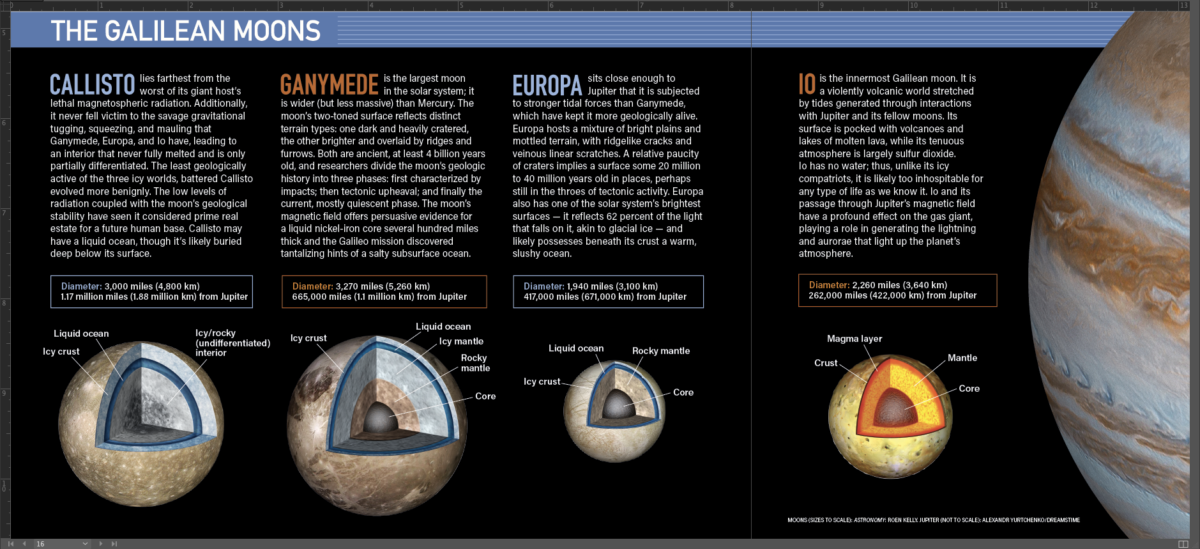
All circled the planet synchronously, with one hemisphere perpetually directed toward their colossal host and the other facing the frigid cold of deep space. But before the Space Age, little else could be learned, as even the best telescopes could not resolve the moons, instead rendering them as meager points of light.
Our earliest robotic visitors, Pioneer 10 and Pioneer 11, which reached Jupiter in December 1973 and December 1974, respectively, furnished little additional detail. It wasn’t until March and July 1979, when Voyager 1 and 2 visited Jupiter, that we got an up-close view. Later, the Galileo probe flew past each moon several times between 1996 and 2002.
Nearest to Jupiter, Io is the odd moon out — not icy but incredibly volcanic, more so than any other solar system world. Regularly squeezed and stretched between Jupiter and its fellow large moons, Io hosts hundreds of volcanoes and an ever-changing surface with lakes not of water, but of molten lava.
Beyond Io are icy Europa, Ganymede, and Callisto. Decades of research have shown they have remarkably diverse histories — but all share the same secret: a potential saltwater ocean hidden beneath a frozen exterior.
Beneath the surface
The Galileo spacecraft’s discovery of glacierlike features and traces of cryovolcanism on Europa in early 1997 prompted notions that deep beneath its granite-hard crust might reside a layer of liquid water or warm, slushy ice up to 100 miles (150 kilometers) deep. Its presence has been further evidenced by Hubble Space Telescope (HST) observations indicating the consistent presence of water vapor in the moon’s atmosphere, in one case reaching 125 miles (200 km) above the surface before falling back to the ground. And several studies have suggested that dark streaks on Europa could be salt deposits left behind by seawater melting its way through the crust and evaporating, bolstering arguments for a warm europan ocean — though some scientists doubt the two layers have ever interacted.
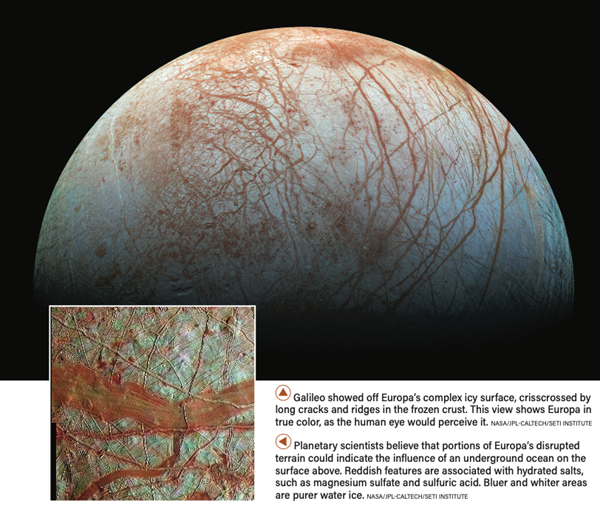
Researchers hypothesize that heat from tidal flexing could keep Europa’s ocean liquid. Additionally, the moon’s interior may be hot enough to melt its rocky mantle, fueling underwater volcanoes and vents. On Earth, such features can provide rich resources for life. (See “Searching for life on watery worlds” on page 36 to learn more.)
Nonetheless, the nature of the moon’s hypothetical ocean remains open to conjecture. Indeed, differing models of the europan interior have argued for a crust as thin as 660 feet (200 meters) in places or as thick as 20 miles (30 km).
Meanwhile, Galileo measurements of Ganymede’s magnetic field are highly suggestive of the presence of electrically conducting fluid, such as an ocean with salinity on par with earthly seawater. Galileo also indicated that, like Europa, Ganymede’s surface exhibits salt minerals that could have been left by exposure to saltwater. A 2015 analysis of the moon’s magnetic field based on observations of its aurorae by HST suggests that Ganymede might harbor the largest ocean in the solar system, some 10 times deeper than Earth’s own oceans, less than 200 miles (330 km) below the surface. Hubble data even indicate Ganymede may possess a “stack” of multiple ocean layers separated by different phases of ice and extending right down to its icy mantle.
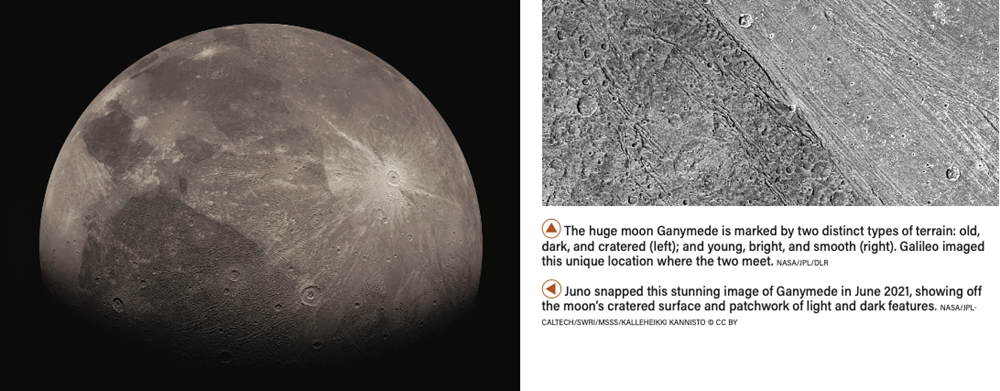
Galileo observations of Callisto’s magnetic field also hinted at a saltwater ocean, possibly deep below the cratered surface — 155 miles (250 km) or more. Though the world is geologically quiescent, its ocean could be kept liquid through insulation from the crust above and heating from below by radioactivity in the core.
With its warmer interior and geologic activity, many researchers see Europa as the most likely breeding ground for potential life in the jovian system. But scientists aren’t yet sure whether the thickness of its crust prevents sunlight and oxygen from reaching the subsurface ocean. Ganymede resides farther from Jupiter’s radiation belts, which perhaps bumps up its habitability somewhat. And while it’s possible that reactions between its water and rock mean Callisto’s ocean could potentially support halophiles — salt-loving organisms found in some environments on Earth — the moon’s insufficient internal energy reserves and geological “deadness” renders this prospect somewhat less likely.
Planning a visit
The tantalizing possibility of salty subsurface oceans — and perhaps even life — on these icy moons has put them high on the wish list of mission planners for decades. In October 2007, ESA short-listed a proposal for a mission called Laplace that would send a trio of spacecraft to Jupiter — including one dedicated to orbiting Europa and another that would make flybys of Ganymede and Callisto.
That same year, NASA began investigating its own mission to the Jupiter system. In early 2009, the two agencies agreed to a joint mission. NASA would build the $3.8-billion Europa orbiter, while ESA would construct a $1-billion craft to perform repeated flybys of Callisto before settling into orbit around Ganymede. Planners envisaged two separate launches around 2020, reaching Jupiter in late 2025 and early 2026 for three years of exploring not just the moons, but the entire jovian system.
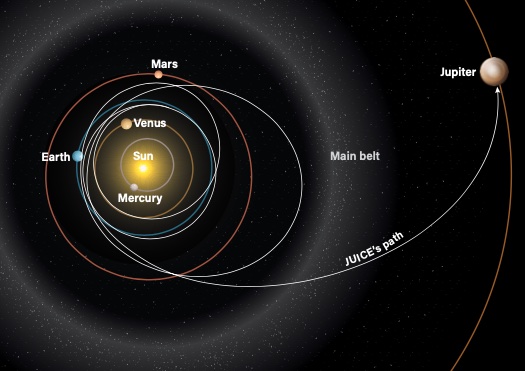
But in March 2011, the U.S. National Academies’ influential decadal survey of the planetary science community found that the massive budget for NASA’s Europa orbiter would threaten too many other important missions. Facing budget cuts, NASA elected to pull out of the effort.
ESA continued to pursue its plans, revamping them yet again to encompass all three major icy moons: Europa, Ganymede, and Callisto. However, adding Europa posed a unique set of challenges. Europa’s proximity to Jupiter means it lies deeper within the radiation belts that surround the planet, requiring heavy and expensive radiation-resistant electronics. Mission designers ultimately reached a compromise, whereby the probe would execute just two Europa flybys. These few, brief flybys would only minimally expose the craft to the intense radiation nearer the planet, meaning simpler, cheaper radiation shielding would suffice to protect its precious cargo of instruments. Planners also tweaked the probe’s orbit around Jupiter, using multiple Callisto flybys to bump its inclination up to around 30°, depending on the final mission profile, ideally allowing it to study Jupiter’s poles.
The mission, renamed JUICE, was estimated to cost roughly 1.1 billion euros ($1.2 billion USD). It received ESA approval in May 2012, with a launch in May or June 2022 and backup opportunities the following year. JUICE was projected to reach Jupiter in 7.6 years, after traversing 373 million miles (600 million km). In early 2013, 10 scientific instruments and one experiment were selected. They fell into three groups: four remote-sensing instruments, three geophysics instruments, and three in-situ payloads.
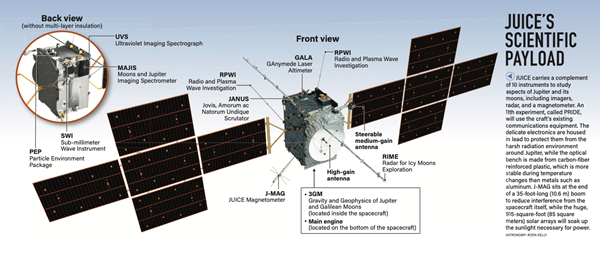
The remote-sensing suite includes the JANUS camera. (JANUS stands for Jovis, Amorum ac Natorum Undique Scrutator, a Latin phrase that translates to “comprehensive observation of Jupiter, his love affairs, and descendants.”) It will image most targets at resolutions better than 1,300 feet (400 m) per pixel, though some may be resolved as fine as 8 feet (2.4 m). JANUS will examine the moons at a global, regional, and local level, as well as map Jupiter’s roiling clouds.
The visible and near-infrared Moons and Jupiter Imaging Spectrometer (MAJIS) will observe tropospheric clouds, gas composition, and aurorae in the jovian atmosphere, plus surface ices and minerals on Ganymede, Europa, and Callisto. The Ultraviolet Imaging Spectrograph (UVS) will examine the moons’ outermost atmospheres and Jupiter’s aurorae and upper atmosphere. The Sub-millimeter Wave Instrument (SWI) will alternate its focus between Jupiter’s rings and atmosphere and the three moons.
Leading JUICE’s geophysics payload is the GAnymede Laser Altimeter (GALA), which will perform topographical measurements with a vertical resolution as fine as 3.9 inches (10 centimeters) at low altitudes. The Radar for Icy Moons Exploration (RIME) will probe the moons’ subsurface structures as deep as 12 miles (20 km). RIME can also achieve a vertical resolution as fine as 100 feet (30 m) to a depth of 5.6 miles (9 km) in ice. The Gravity and Geophysics of Jupiter and Galilean Moons (3GM) will use radio waves to trace the strength of Ganymede’s gravitational field and further measure the extent of any subsurface ocean in the three icy moons.
The Particle Environment Package (PEP), Radio and Plasma Wave Investigation (RPWI), and JUICE Magnetometer (J-MAG) will study the magnetic and plasma environment in the jovian system, plus investigate how the magnetic fields of Jupiter and Ganymede interact. And the Planetary Radio Interferometer and Doppler Experiment (PRIDE) will communicate with Earth-based radio telescopes to precisely map the spacecraft’s location in space, yielding detailed information about the planet and moons’ gravitational fields.
Path to exploration
Scheduled to launch between April 5 and 25, JUICE will spend three months completing a near-Earth commissioning phase. Next, the spacecraft will enter a lengthy cruise phase that ends in January 2031, when it will begin gearing up to enter Jupiter orbit. During the cruise, there will be little input from Earth, with one check-in each week. JUICE’s instruments will also be checked twice yearly during the long, dark trek to Jupiter.
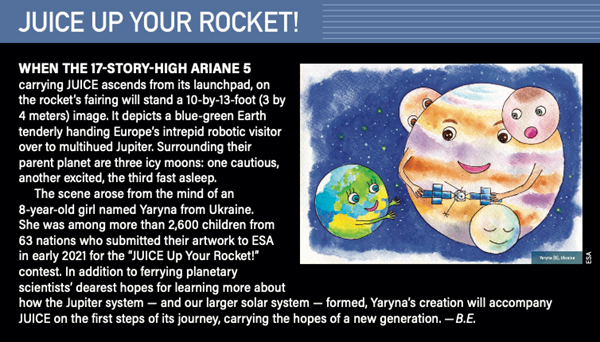
To get to the gas giant, the spacecraft requires a series of gravitational boosts from four planetary encounters. These kick off with a first-of-its-kind dual flyby of the Earth-Moon system, known as a lunar-Earth gravity assist, in August 2024. JUICE will first get an assist from our Moon, then 36 hours later receive another from our home planet.
A year later, in August 2025, JUICE will pass Venus before its lazy, looping solar orbit provides two final Earth flybys in September 2026 and January 2029. JUICE will then hurtle through the main belt twice, possibly passing at close range to asteroid 223 Rosa in October 2029.
Traveling so close to and so far from the Sun imposes critical demands on the spacecraft and its twin solar arrays. Each array comprises five panels of gallium arsenide cells, totaling 915 square feet (85 square meters) and furnishing 820 watts of electricity. During its Venus flyby, the arrays must be tilted to prevent damage from excessive temperatures, while at jovian distances, incident sunlight will be 25 times weaker than near Earth. High-efficiency, multi-layered insulation will help to moderate external temperatures when JUICE is nearest the Sun, and also limit heat leakage at distant Jupiter.
Arriving in the jovian realm in July 2031, JUICE will execute its first flyby of Ganymede before entering an elongated orbit around Jupiter. Over time, this orbit will be lowered and circularized. Two encounters with Europa are targeted for July 2032, after which the spacecraft will gradually boost its inclination through successive Callisto flybys between August 2032 and August 2033. This will set up its transfer to Ganymede. JUICE will enter orbit around the giant moon in December 2034 for almost a year of close-range observations, becoming the first spacecraft in history to orbit a natural satellite other than our Moon.

Its initial orbit around Ganymede will be highly elliptical, as JUICE undertakes a global geological mapping campaign. The altitude will be gradually adjusted to 310 miles (500 km), allowing JUICE to investigate Ganymede’s subsurface ocean and deeper interior, as well as its icy shell, atmosphere, and plasma environment. After its propellant finally runs out, JUICE will naturally impact Ganymede’s surface sometime late in 2035.
As Europe’s first independent foray beyond the asteroid belt, JUICE is breathtaking in its scope and spellbinding in its daring. The 10th spacecraft to visit the jovian system, it follows in the footsteps of those that came before but will carve out its own important niche in the history books as the best chance of finding water oceans — and life — beyond our own small patch of the solar system.


